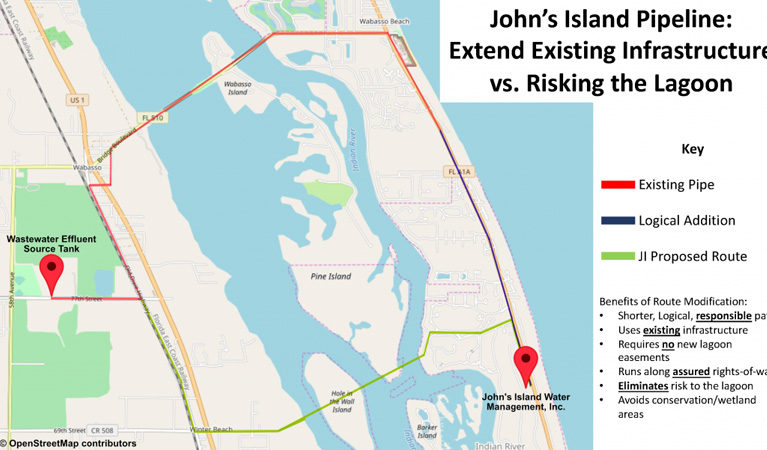
Opponents in the quarrel over an effort by John’s Island to install an irrigation water pipeline 80 feet beneath the Indian River Lagoon are rallying their troops for a show of force at the April 23 County Commission meeting.
Supporters and foes of the $6-million project are circulating petitions and calling for their followers to attend the meeting where commissioners are expected to review two crucial pipeline-related items.
The first is a consultant’s report on whether it would be feasible to install a new irrigation pipeline in the crowded underground utility right-of-way along A1A from Wabasso Beach Road south to John’s Island instead of tunneling under the lagoon.
The second is a request for a temporary construction easement under Hole in the Wall Island so a contractor can install a 16-inch pipe beneath the lagoon to carry reuse water to John’s Island from Indian River County’s Sea Oats Wastewater Treatment Plant on 77th Street.
The commissioners could effectively block the subaqueous pipeline project by denying the easement request for the old Winter Beach Road bridge right-of-way.
The A1A pipeline feasibility study by the Schulke, Bittle & Stoddard engineering firm would tell the commissioners whether there is room in the roadside right-of-way for a new irrigation pipeline as an alternative to the lagoon route.
Public concern about the John’s Island irrigation pipeline project is so great, county officials anticipate releasing the consultant’s report to the public on April 17, two days earlier than normal, to give people more time to review the report ahead of the April 23 meeting.
County officials are also bracing for a packed commission chamber the day of the meeting.
“There has been a lot of interest in this project and we anticipate a good crowd,” said County Administrator Jason Brown. “We’ve heard a lot from proponents and opponents of the project.”
The John’s Island Property Owners Association and its water management company plan to spend $6 million to construct the pipeline, which would carry up to 2 million gallons of re-use water per day to the barrier island.
The new pipeline is needed because John’s Island requires 1 million gallons of re-use water a day to maintain lawns and landscaping, said Mike Korpar, the community’s general manager.
Some days John’s Island currently gets as little as 100,000 gallons from the City of Vero Beach irrigation pipeline, Korpar said. That’s because John’s Island is at the end of the pipeline and there is not enough re-use water left.
John’s Island would be first in line for re-use water from the new irrigation pipeline, Korpar said. “We need this re-use water. It’s not just we’d like to get some. We need it.”
After it is built, John’s Island would turn the completed pipeline over to the county Department of Utility Services, which would maintain and operate it, according to the terms of a December 2017 agreement.
Any leaks or other issues would be the department’s responsibility, said county Utilities Director Vincent Burke.
Re-use water is a byproduct of the sewage treatment process after biosolids and some contaminants are removed, state environmental records show. It is considered an environmentally friendly alternative to using potable water for irrigation.
John’s Island and several environmental and civic groups are circulating petitions and organizing their members to show commissioners there is public support for their position on the irrigation pipeline project.
Several environmentalists oppose the idea because of concerns the pipeline could leak polluted water into the lagoon and surficial aquifer without anyone realizing it.
“If it breaks at 80 feet below the lagoon, we’re destined for a catastrophic event,” said Paul Falfeita, a river fishing guide. “Why roll the dice?
“We can anticipate if this pipeline goes through, it’s just a matter of time before it starts leaking nutrients and other contaminants into the lagoon,” said Leesa Souto, executive director of the Marine Resources Council.
“The risk is to all of us and the benefit is to a very small part of the community. That’s just not fair.”
If re-use water is going to be used for irrigation on the island, then it should be piped across the lagoon on a bridge so any leaks can be immediately detected, Souto and Falfeita said.
In addition to the Marine Resources Council, the groups mobilizing against the pipeline include the Pelican Island Audubon Society and the Indian River Neighborhood Association.
Korpar argued that John’s Island Water Management is taking every precaution possible to ensure the pipeline meets all government standards and protects the environment.
The government agencies reviewing the project include the U.S. Army Corps of Engineers, Florida Department of Environmental Protection and St. Johns River Water Management District, among others, Korpar said.
“It’s not going to harm the environment or be a risk to anyone,” Korpar said. “The Indian River Lagoon means a lot to John’s Island as well. We definitely don’t want to damage it.”



